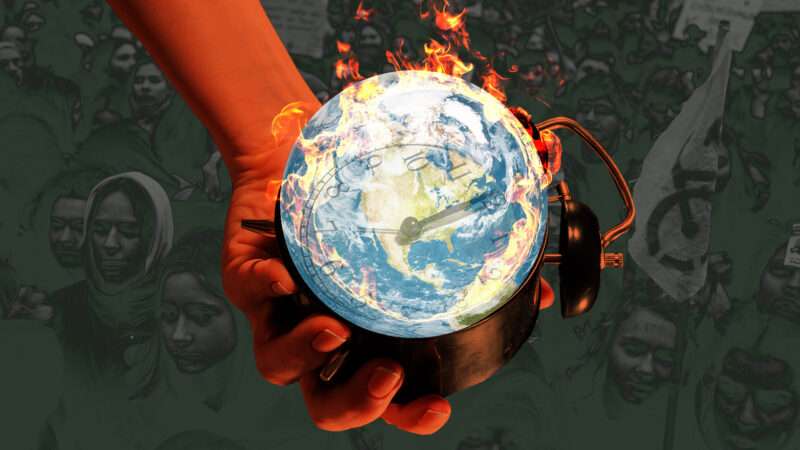
Many officials and climate activists claim we have only 12 years to act on global warming. Where does this figure come from? A 2018 Special Report by the Intergovernmental Panel on Climate Change (IPCC). The second sentence of that document reads, “Global warming is likely to reach 1.5 degrees C between 2030 and 2052 if it continues to increase at the current rate.” The 12-year figure comes from subtracting the year of the report, 2018, from the earliest possible date of 1.5 degrees C warming, 2030.
The problem is that this was a statement about the past, dressed up to suggest that it’s about the future. It’s not about what will happen; it’s extrapolating from what has already happened. Actual temperatures in 2030 will depend on whether warming speeds up or slows down, and also on whether the year is warmer or colder than the long-term trend.
Why the 22-year range? The authors of the IPCC report defined the current rate using data from 1960 to 2017. Using the NASA Goddard Institute for Space Studies (GISS) land-ocean temperature series that underpins most popular reporting about warming, global excess temperatures were 0 in January 1960 and 0.94 degrees C in December 2017. So the Earth has to warm another 0.56 degrees C to reach 1.5 degrees C. Some fifth-grade math tells us that should happen in 34.55 years if warming continues at the same rate. We’d hit 1.5 degrees C on July 21, 2051. Different measurements might give a couple of years either way, but not 22 years.
The range of 2030 to 2052 is not about how warm the earth is but who’s responsible for the change in temperature. The figures reflect “anthropogenic warming,” or warming rooted in human activity. By citing a range of 2030 to 2052, the authors are indicating a high level of uncertainty. They’re not sure how much of the 0.17 degrees C per decade warming is “anthropogenic,” or rooted in human activity. They think it’s possible that humans are warming the Earth 0.3 degrees C and some unknown factor is actually cooling the Earth 0.13 degrees C. (The IPCC declined to make any of the report’s authors available for an interview).
If you think the problem with global warming is hotter temperatures (melting ice, rising sea levels, and other physical effects), then you should care about the year 2052, not 2030. But if you think the problem with global warming is that humans are tampering with something pristine—and you only consider the worst possible scenario—then 2030 is your date. Focusing on anthropogenic warming suggests that what’s happening in the real world matters less than who’s at fault.
Not all environmental change is bad. We hear about possible species extinctions, but not about the species that will thrive and diversify on a warmer planet (for example, insects and sea life may be increasing in numbers and variety due to warming to date, although this is controversial). In any event, no one knows the optimal rate of speciation and extinction. We like majestic old-growth forests and exquisite biologic specializations where the climate is stable, as well as the vibrant adaptations and innovations in fast-changing environments.
Furthermore, far more of the Earth’s surface is too cold for humans than too warm at the moment. Historically, warm periods are more prosperous than cold ones, and more people die in cold months than warm ones. In addition, destructive weather events are not concentrated in the warmest months or the warmest places, so there’s no direct reason to expect more of them in a warmer world. Carbon dioxide is good for plants, and plants are good for both people and the environment.
Granted, there is reason to prefer less change to more, because more change could tip off catastrophic cascades. We know we can live with current temperatures; we can’t be sure we’ll be happy if things get significantly warmer. And even if a warmer world is better in some ways, the benefits could be overwhelmed by the transition costs. But these are arguments to reduce the overall human environment footprint rather than to reduce the temperature by any means necessary.
This is where the 12-years-until-disaster alarmism becomes toxic. Lowering 2030 temperatures significantly requires wide-scale geoengineering—for example, scattering glass beads on arctic ice or injecting sulfur into the stratosphere to reduce the temperature immediately (the IPCC report emphasizes carbon sequestration, a possibly less risky form of geoengineering, but also says that sequestration and emission reductions are not enough). Crude, dramatic rules like banning coal or outlawing airplanes could slash emissions quickly, but the effects would not be fully felt in temperatures for up to a decade. Moreover, those approaches increase the human impact on the environment and introduce more uncertainty into future climate. They may bring down global temperatures by 2030, but at the cost of introducing greater long-term uncertainty and possibly tripping more catastrophic cascades.
Policies like a carbon tax or building nuclear power plants take years to implement, and only begin to reduce the rate of CO2 emissions. These work for planning horizons like 2 degrees C by 2050. But they have environmental benefits beyond temperature, their effects are more predictable than panic rules, and they’re more likely to be maintained as political winds change.
Even better would be long-term, sustainable, global agreements to leave fossil fuels in the ground permanently. These agreements could take decades to nurture and make sense if we focus on 2100. They could serve to address global issues, including many environmental ones, and to support world peace and prosperity. They won’t cool the Earth by 2030, possibly not even by 2050, but they could deliver a better world to our grandchildren. Alarmist panic interferes with such rational consensus building.
Which brings us back to the IPCC special report. It contains two contradictory threads, likely as a result of being written by a committee. The 2030 date relies on huge uncertainty about how much global warming has been caused by humans—a factor of three between 0.1 degrees C per decade to 0.3 degrees C. But later the report cites studies that conclude, “human-induced warming trends over the period 1905–2005” are “indistinguishable from the corresponding total observed warming.” If the latter claim is true, then we know the rate of anthropogenic warming, and it will hit 1.5 degrees C if the rate remains the same in more like 30 years than 12 years.
If we don’t understand climate to the point that we have a 3:1 uncertainty band about anthropogenic contributions to warming, it’s foolhardy to rush in with radical changes. When you don’t understand a complex system, but you do know there are powerful offsetting forces at work, you should be cautious about fooling with it. So, on one hand, if we understand climate well enough to know the amount of anthropogenic warming, the rate is not high enough to cause a crisis by 2030 if it does not accelerate. On the other hand, if we don’t understand the climate well enough to be confident of the anthropogenic contribution, we should avoid massive, rushed experiments.
Even if everything the alarmists say is true, 2030 is not a feasible planning horizon. It admits only panic solutions that increase long-term uncertainty. You don’t plan for the horizon you want to control, you plan for the horizon you can control. The climate in 2030 is already baked in—we should worry about dealing with it, not changing it. The climate in 2050 is in play, with many attractive policy choices to be implemented with sense, prudence, trial, and error.
Video credits:
Produced and edited by Justin Monticello. Written by Monticello and Aaron Brown. Camera by Zach Weissmueller. Graphics by Isaac Reese. Audio production by Ian Keyser.
Music: Aerial Cliff by Michele Nobler, Land of the Lion by C.K. Martin, Thoughts by ANBR, Flight of the Inner Bird by Sivan Talmor and Yehezkel Raz, and Run by Tristan Barton.
Photos: Alterphotos/Abaca/ZUMA Press/Newscom; Sachelle Babbar/ZUMA Press/Newscom; (EyePress Newswire/FL Wong)/Newscom; Hermann Bredehorst/Polaris/Newscom; BENOIT DOPPAGNE/BELGA/Newscom; Alterphotos/Abaca/ZUMA Press/Newscom; Kay Nietfeld/dpa/picture-alliance/Newscom; WixtrÖM Peter/Aftonbladet/Tt/ZUMA Press/Newscom; Andrea Ronchini/ZUMA Press/Newscom; Beata Zawrzel/ZUMA Press/Newscom; Gina M Randazzo/ZUMA Press/Newscom; Yichuan Cao/Sipa USA/Newscom; Roberto Almeida Aveledo/ZUMA Press/Newscom; Sachelle Babbar/ZUMA Press/Newscom; Ben Birchall/ZUMA Press/Newscom; Sadak SouiciLe Pictorium/ZUMA Press/Newscom; Gina M Randazzo/ZUMA Press/Newscom; Andrea Ronchini/ZUMA Press/Newscom; Hermann Bredehorst/Polaris/Newscom; WixtrÖM Peter/Aftonbladet/Tt/ZUMA Press/Newscom; SUSANA VERA/REUTERS/Newscom; UNclimatechange from Bonn, Germany, CC BY 2.0, via Wikimedia Commons
from Latest – Reason.com https://ift.tt/3u9GWlF
via IFTTT







